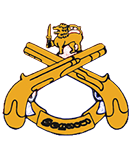The Sri Lanka Army was established on 10th October 1949 subsequently after achieving independence on 4th February 1948 making our country a free and sovereign state which once prevailed as a colony under the British Crown. As per the Royal Army Structure, the police duties in the Army were handled by the Royal Military Police. With the establishment of the Sri Lanka Army, the necessity of a Provost Company was highlighted. Due to that reason as per the RMP structure, the first provost platoon was established on the 10th of October 1949 by Sherly of Kening (British) at Colombo Race Course with an officer who was wearing a Blue berate and with nine NCOs and they were called the red cap platoon there onward.
The following Military Police Companies were established gradually from 1952 with the development of the Sri Lanka Army.
Establishing the 2nd Military Police Company at Diyatalawa in 1952.
Establishing the 3rd Military Police Company at Panagoda in 1953.
Establishing the 4th Military Police Company at Thalei Mannar in 1957.
Establishing the 5th Military Police Company at Jaffna in 1957.
Establishing the 6th Military Police Company at Ampara in 1961.
Establishing the 7th Military Police Company at Kanthale in 1961.
Establishing a Military Police Company at Army HQ in 1971.
Establishing the 8th Military Police Company at Anuradhapura in 1973.
Establishing the 9th Military Police Company at Boossa in 1975.
From 1949 to 1974 Military Police shifted their Headquarters from place to place. In 1978 the Corps of Military Police was permanently located at Elvitigala Mawatha, Narahenpita. In the same year the Military Police was bestowed with the rare honour of performing the ceremonial, the President's Ceremonial Guard Company was formed. The introduction of the Sri Lanka Army Women's Corps gave the necessity to maintain the discipline of the women soldiers, and the Provost Section of MP women was established in 1983.
The increase of strength in the Corps paved the way for opening a Regimental Centre at Narahenpita on 30 Apr 1990. Maj Gen KAMG Kularathne was appointed as the first Colonel of the Regiment in the Sri Lanka Corps of Military Police. The Special Investigation Branch has now expanded to a Special Investigation Unit, directly functioning under the Directorate of Provost Marshal. There are 7 Regular units in the Corps of Military Police as at present.
Role and Task SLCMP
The role of SLCMP is to police the Army both in peace and war. This role is summarized as follows:
1. Tactical police support to the army in all phases of operation.
2. Law enforcement and crime prevention within the army in peace and war.
3. The provision of garrison police duties.
The principal tasks through which the role is full file date: -
The Principal tasks through which the role is full file date:-
a. Traffic Control
(1) Supervising all Military troops and routes by providing
(2). The maintenance of road safety.
-
(a) Speed check
(b) Courtesy patrols and road safety instruction.
(c) Investigation of traffic accident.
b. Information and assistance
(1) Static police posts at military garrison.
(2) Maintenance of Information posts/Charge rooms which assist in the provision of the follows.
-
(a) Routes
(b) Formation HQs and other installation.
(c) Road condition report.
(d) Lost and found property.
(3). Assistance in the search for missing person
-
c. Prevention of crime
(2) Regular patrolling of all military location and towns /Place where frequent out of soldiers bound areas.
d. Detection and apprehension of offenders
(1.) Investigation and reporting on all notified offences.
(2.) Sealing, collecting and preparing evidence of offences.
(3.) Arresting of offences when necessary.
(4.) Documenting and training servicemen absent without leave.
(5.) Maintenance of all criminal records.
(6.) Maintenance specialist teams ( Investigation)
e. Control of access to places and events
f. Advice of the custody of PW and their movements.
g. Refuges control
h. Ceremonials duties
i. Liaison with civil police





